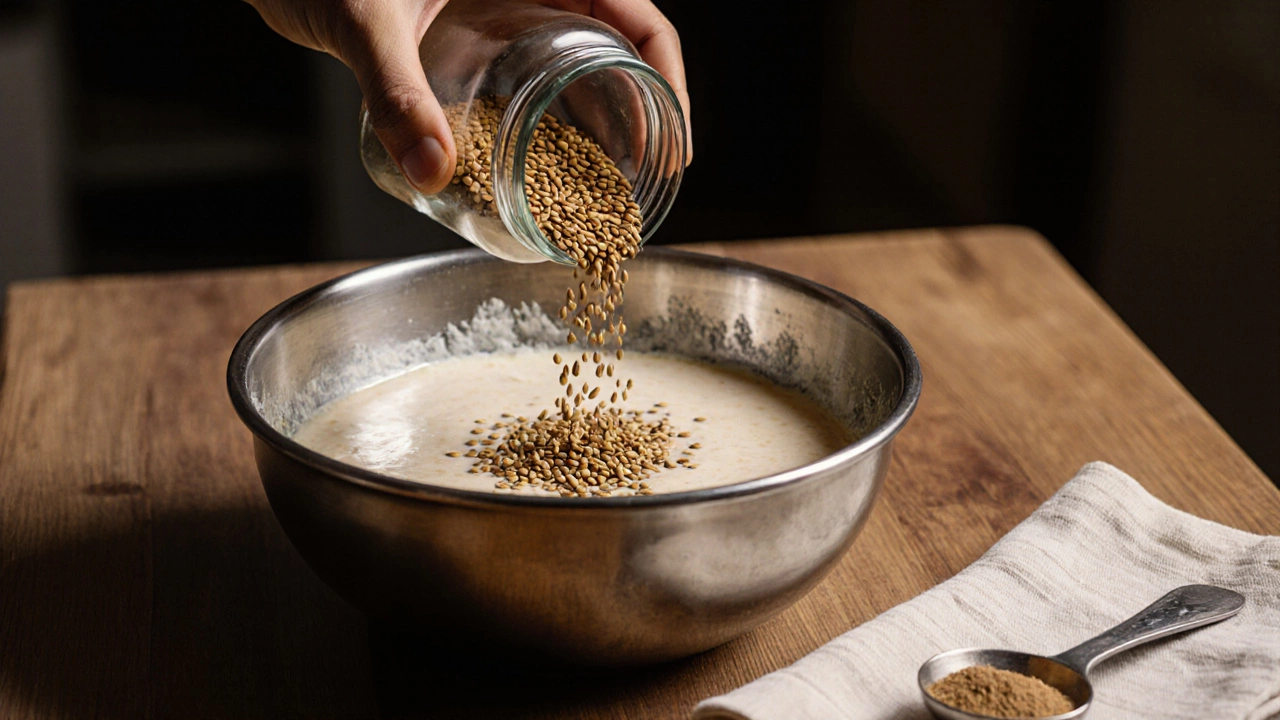Fenugreek Dosa Batter
When working with fenugreek dosa batter, a fermented rice‑and‑lentil mixture infused with ground fenugreek leaves or seeds. Also known as methi dosa batter, it serves as the base for many South Indian dishes. This batter isn’t just another breakfast option; it brings a subtle bitterness, a lovely aroma, and a boost of nutrition that regular rice‑only batter often misses. If you’ve ever wondered why some dosas taste richer or why they stay fluffy longer, the answer usually lies in the quality of the batter and the way it’s fermented.
Another key player here is Dosa, a thin, crisp crepe made from a fermented batter of rice and lentils. Dosa belongs to the larger family of South Indian cuisine, the culinary tradition of states like Tamil Nadu, Karnataka, Kerala, and Andhra Pradesh. Within this tradition, the batter’s texture, the fermentation period, and the added spices decide whether you get a silky plain dosa, a crunchy masala dosa, or a nutty ragi dosa. Adding fenugreek takes the classic experience a step further, giving the crepe a peppery edge that pairs perfectly with coconut chutney or tomato sambar.
The magic behind the batter’s rise is Fermentation, a natural process where microbes break down carbohydrates into acids and gases. During fermentation, lactic‑acid bacteria and wild yeasts multiply, creating that signature sour tang and airy texture. A well‑fermented fenugreek dosa batter will show tiny bubbles on the surface, a pleasant fragrance, and a pH drop that makes it easier to digest. For most kitchens, a 12‑ to 18‑hour warm room temperature works, but colder climates may need a longer period or a small amount of starter batter to kick‑start the microbes.
How to Make the Perfect Fenugreek Dosa Batter
Start with equal parts raw rice and split urad dal (black gram). Soak them separately for at least four hours, then grind them to a smooth paste with a little water. Add 1‑2 teaspoons of dry fenugreek seeds that you’ve soaked and ground into a fine powder; this not only imparts flavor but also introduces natural enzymes that aid fermentation. Mix the two pastes, add a pinch of salt, and let the batter sit in a wide, shallow container—this gives the microbes room to expand. Stir once or twice a day to release trapped gases.
Temperature is the biggest variable. Aim for 30‑35 °C (86‑95 °F) during the day. If you’re using a kitchen cabinet with a light on, it often stays warm enough. In cooler homes, wrap the container in a towel or place it near a radiator. After the batter has doubled in volume and you see a frothy layer, it’s ready. Test it by dropping a spoonful on a hot tawa; if it bubbles and spreads easily, you’re good to go.
Consistency matters. Too thick, and the dosas will be dense; too thin, and they’ll tear. A ladle‑size pour should spread into a 6‑inch circle within 10‑15 seconds. Adjust with water, but keep the fenugreek proportion at about 5‑7 % of the total dry weight; more can overwhelm the subtle flavor and make the batter bitter.
Storage tips: Once fermented, you can refrigerate the batter for up to three days. The cold slows microbial activity, preserving the tang. If you notice a strong sour smell after a few days, give it a quick stir, add a splash of water, and let it warm up for an hour before using. For longer storage, freeze in ice‑cube trays; just thaw at room temperature and give it a good stir before cooking.
Health benefits are a bonus. Fenugreek is rich in soluble fiber, which helps regulate blood sugar and supports digestion. It also contains compounds like diosgenin that may aid cholesterol management. When combined with the probiotic boost from fermentation, you get a breakfast that’s both tasty and gut‑friendly. Vegans and vegetarians especially love this batter because it provides a complete protein profile thanks to the lentils, while keeping the dish plant‑based.
Variations are endless. Mix in a handful of grated carrots or beetroot for color and extra nutrients. Replace part of the rice with millet or quinoa for a gluten‑free twist. For a spicier version, add a pinch of red chili powder or crushed black pepper when grinding the fenugreek. Each tweak creates a new flavor layer but still respects the core principle: a well‑fermented, fenugreek‑infused batter that yields a light, crispy dosa.
Now that you understand the science, the ingredients, and the tricks, you’re ready to explore the recipes and tips below. Whether you’re a beginner looking for a step‑by‑step guide or an experienced cook hunting for creative twists, the collection ahead covers everything from basic batter preparation to advanced flavor combos, giving you the confidence to serve perfect fenugreek dosas any time you crave them.
Why Fenugreek Is Added to Dosa Batter - Benefits, Flavor & Tips
Discover why fenugreek is added to dosa batter, how it boosts fermentation, flavor and nutrition, and get practical tips for perfect dosas every time.
